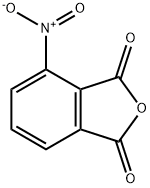5-Fluoro-1,3-isobenzofurandione
- CAS NO.:319-03-9
- Empirical Formula: C8H3FO3
- Molecular Weight: 166.11
- MDL number: MFCD00191363
- EINECS: 1312995-182-4
- SAFETY DATA SHEET (SDS)
- Update Date: 2025-07-04 15:08:07

What is 5-Fluoro-1,3-isobenzofurandione?
Chemical properties
white to light yellow crystal powder
The Uses of 5-Fluoro-1,3-isobenzofurandione
4-Fluorophthalic anhydride is used in the preparation of 5-fluoro-2-pyridin-3-ylmethyl-isoindole-1,3-dione by reacting with C-pyridin-3-yl-methylamine.
The Uses of 5-Fluoro-1,3-isobenzofurandione
4-Fluorophthalic anhydride can be used as a reactant to prepare:
- 4-amino substituted phthalimides applicable as potential fluorescent probes and fluorescent bioactive compounds.
- 4,4′-bis(4-fluorophthalimido)diphenyl ether monomer, which is used in the synthesis of cardo polymers via nucleophilic substitution polymerization reaction.
- Asymmetric polyimides by a solution polycondensation reaction.
General Description
4-Fluorophthalic anhydride is a fluorinated building block commonly used in chemical synthesis for the preparation of polyimide, pesticides, herbicides, and fungicides. It can be synthesized by treating 4-chlorophthalic anhydride with potassium fluoride.
Properties of 5-Fluoro-1,3-isobenzofurandione
| Melting point: | 75-79 °C (lit.) |
| Boiling point: | 148°C 20mm |
| Density | 1.55 |
| Flash point: | >93°C |
| storage temp. | Inert atmosphere,Store in freezer, under -20°C |
| solubility | Soluble in sodium hydroxide. |
| form | powder to crystal |
| color | White to Almost white |
| Sensitive | Moisture Sensitive |
| BRN | 131281 |
| CAS DataBase Reference | 319-03-9(CAS DataBase Reference) |
| EPA Substance Registry System | 1,3-Isobenzofurandione, 5-fluoro- (319-03-9) |
Safety information for 5-Fluoro-1,3-isobenzofurandione
| Signal word | Danger |
| Pictogram(s) |
 Skull and Crossbones Acute Toxicity GHS06 |
| GHS Hazard Statements |
H301:Acute toxicity,oral H315:Skin corrosion/irritation H319:Serious eye damage/eye irritation H335:Specific target organ toxicity, single exposure;Respiratory tract irritation |
| Precautionary Statement Codes |
P302+P352:IF ON SKIN: wash with plenty of soap and water. P305+P351+P338:IF IN EYES: Rinse cautiously with water for several minutes. Remove contact lenses, if present and easy to do. Continuerinsing. |
Computed Descriptors for 5-Fluoro-1,3-isobenzofurandione
| InChIKey | XVMKZAAFVWXIII-UHFFFAOYSA-N |
New Products
Indole Methyl Resin tert-butyl 9-methoxy-3-azaspiro[5.5]undecane-3-carboxylate Boc-His(Boc)-OH 2-CTC Resin 4-Chloro-7-tosy1-7Hpyrrolo[2,3-d]pyrimidine 5,7-Dibromo-1H-indole 2,5-dichloro-N-hydroxy-4,6-dimethylpyridine-3-carboximidamide 2,2-Dimethoxy-7-azaspiro[3.5]nonane hydrochloride 4-chloromethyl-5-methyl-1,3-dioxol-2-one (DMDO-Cl) R-2-BENZYLOXY PROPIONIC ACID 1,1’-CARBONYLDIIMIDAZOLE 1,1’-CARBONYLDI (1,2-4 TRIAZOLE) N-METHYL INDAZOLE-3-CARBOXYLIC ACID 4-((2-hydroxyethyl)thio)benzoic acid 1-(TERT-BUTOXYCARBONYL)-2-PYRROLIDINONE Methyl 6-methylnicotinate 3-Pyridineacrylic acid tert-Butyl carbazate TETRAHYDRO-2H-PYRAN-3-OL 2-((4-morpholinophenylamino) (methylthio) methylene) malononitrile 3-(4-morpholinophenylamino)-5-amino-1H-pyrazole-4-carbonitrile 2,4-dihydroxybenzaldehyde 1,3-Diethyl-1,3-Diphenylurea Methyl 2-methylquinoline-6-carboxylateRelated products of tetrahydrofuran








You may like
-
 4-Fluorophthalic Anhydride CAS 319-03-9View Details
4-Fluorophthalic Anhydride CAS 319-03-9View Details
319-03-9 -
 4-Fluorophthalic anhydride CAS 319-03-9View Details
4-Fluorophthalic anhydride CAS 319-03-9View Details
319-03-9 -
 Pyridine 99.5% HPLC /UV SpectroscopyView Details
Pyridine 99.5% HPLC /UV SpectroscopyView Details
110-86-1 -
 Piperazine Spot supply, best priceView Details
Piperazine Spot supply, best priceView Details
110-85-0 -
 Dibutyl PhthalateView Details
Dibutyl PhthalateView Details
84-74-2 -
 Imidazole Spot supply, competitive priceView Details
Imidazole Spot supply, competitive priceView Details
288-32-4 -
 Octadecyl 3-(3,5-di-tert-butyl-4-hydroxyphenyl)propionate 98% (GC)View Details
Octadecyl 3-(3,5-di-tert-butyl-4-hydroxyphenyl)propionate 98% (GC)View Details
2082-79-3 -
 Thiourea 99% ARView Details
Thiourea 99% ARView Details
62-56-6
Statement: All products displayed on this website are only used for non medical purposes such as industrial applications or scientific research, and cannot be used for clinical diagnosis or treatment of humans or animals. They are not medicinal or edible.
